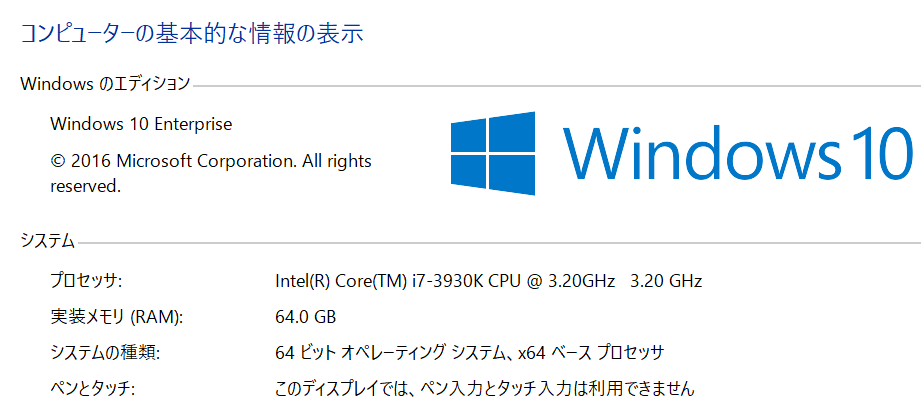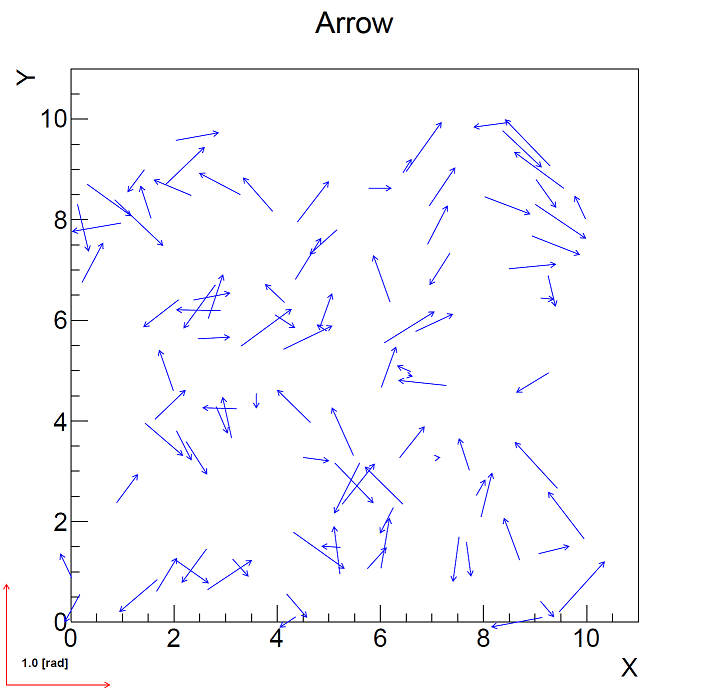
Windows Updateを生かしたまま、アップデート後の不本意な再起動を止める方法は存在しない。Pro版でも、Enterprise版でも。
なので、Windows Updateのサービスを止めるしかない。という結論にたどり着いた。
諦めよう、Microsoftが改心するまで。
2019年現在、この記述は無効です。

Windows Updateを生かしたまま、アップデート後の不本意な再起動を止める方法は存在しない。Pro版でも、Enterprise版でも。
なので、Windows Updateのサービスを止めるしかない。という結論にたどり着いた。
諦めよう、Microsoftが改心するまで。
2019年現在、この記述は無効です。
CERNが開発しているROOT (バージョン5)を用いた検出器内の飛跡を2次元プロジェクションに投影して描画する方法。 具体的には三次元情報を持つ飛跡を2次元に投影したい時に使う。
#include <vector> #include <random> #include <limits> #include <TArrow.h> #include <TGraph.h> #include <TAxis.h> #include <TCanvas.h> #include <TPaveText.h> class Track { public: double px, py, ax, ay; }; int main() { std::random_device rand; std::vector<Track> vtrack; double width = 10; double height = 10; TCanvas *c1 = new TCanvas("c1", "", 1000, 1000); for (int i = 0; i < 100; i++) { Track t; t.px = double(rand()) / std::numeric_limits<unsigned int>::max() * width; t.py = double(rand()) / std::numeric_limits<unsigned int>::max() * height; t.ax = double(rand()) / std::numeric_limits<unsigned int>::max() - 0.5; t.ay = double(rand()) / std::numeric_limits<unsigned int>::max() - 0.5; vtrack.emplace_back(t); } double extz = 2; //ファクター double arrowsize = 0.01; TGraph* dummy = new TGraph(); dummy->SetPoint(0, 0, 0); //左下 dummy->SetPoint(1, width , height ); //右下 dummy->SetMarkerColor(0); //マーカー色は白に dummy->GetXaxis()->SetTitle("X"); dummy->GetXaxis()->SetLabelSize(0.04); dummy->GetXaxis()->SetTitleSize(0.04); dummy->GetYaxis()->SetTitle("Y"); dummy->GetYaxis()->SetLabelSize(0.04); dummy->GetYaxis()->SetTitleSize(0.04); dummy->SetTitle("Arrow"); dummy->Draw("AP"); //軸とポイントを描画 for (auto p : vtrack) { TArrow *arrow = new TArrow(p.px, p.py, p.px + (p.ax)*extz, p.py + (p.ay)*extz, arrowsize, ">"); arrow->SetFillColor(kBlue); arrow->SetLineColor(kBlue); arrow->SetFillStyle(1001); arrow->SetLineWidth(1); arrow->SetLineStyle(1); arrow->Draw(); } //リファレンスの矢印 double ref_px = -width / 8, ref_py = -height / 8; { TArrow *arrow = new TArrow(ref_px, ref_py, ref_px + extz, ref_py, arrowsize, ">"); arrow->SetFillColor(kRed); arrow->SetLineColor(kRed); arrow->SetFillStyle(1001); arrow->SetLineWidth(1); arrow->SetLineStyle(1); arrow->Draw(); } { TArrow *arrow = new TArrow(ref_px, ref_py, ref_px, ref_py + extz, arrowsize, ">"); arrow->SetFillColor(kRed); arrow->SetLineColor(kRed); arrow->SetFillStyle(1001); arrow->SetLineWidth(1); arrow->SetLineStyle(1); arrow->Draw(); } //リファレンスの文字 double text_px = -width / 10, text_py = -height / 10; { TPaveText *pt = new TPaveText(text_px, text_py, 0, text_py + height / 30, "br"); pt->SetFillColor(0); pt->SetLineColor(0); pt->SetShadowColor(0); TText *text = pt->AddText("1.0 [rad]"); pt->Draw(); } c1->SaveAs("Arrow.pdf"); return 0; }
作った画像

2個の数列から重複等を探す方法を紹介する。Linuxのjoinコマンドを高速化する場合などに使える。
続きは 2個の自作クラスの配列(std::vector<MyClass>)から重複とかを探す - 物理の駅 Physics station by 現役研究者
#include <algorithm>に便利な関数が用意されている。
ソートして、重複を削除した後、set_intersection, set_union, set_differenceを使ってみよう。
参照
Tech Tips: 知ってると便利なSTL(10) set_intersection, set_union, set_difference
乱数発生器についてのコードを修正しました(2016/11/30)
list1 = {5,7,4,2,9}
list2 = {4,3,8,3,2}
↓ソート
list1 = {2,4,5,7,9}
list2 = {2,3,3,4,8}
↓重複を削除
list1 = {2,4,5,7,9}
list2 = {2,3,4,8}
↓比較
積集合 = {2,4}
和集合 = {2,3,4,5,7,8,9}
差集合1 = {5,7,9}
差集合2 = {3,8}
#include <random> #include <vector> #include <algorithm> #include <iostream> #include <iterator> void main() { const int Ntrk = 10000000; std::random_device rd; std::mt19937 gen(rd()); std::uniform_int_distribution<> dis(0, Ntrk - 1); std::vector<unsigned int> list1, list2; for (int i = 0; i < Ntrk; ++i) { list1.emplace_back(dis(gen)); //乱数を作成 list2.emplace_back(dis(gen)); //乱数を作成 } std::sort(list1.begin(), list1.end()); //ソート std::sort(list2.begin(), list2.end()); //ソート std::cout << list1.size() << " -> "; //重複を削除 list1.erase(std::unique(list1.begin(), list1.end()), list1.end()); std::cout << list1.size() << std::endl; std::cout << list2.size() << " -> "; //重複を削除 list2.erase(std::unique(list2.begin(), list2.end()), list2.end()); std::cout << list2.size() << std::endl; std::vector<unsigned int> list_inter; //list1とlist2の両方にある値 (積集合) std::set_intersection(list1.begin(), list1.end(), list2.begin(), list2.end(), std::back_inserter(list_inter)); std::vector<unsigned int> list_union; //list1かlist2のどちらかに存在する値(和集合) std::set_union(list1.begin(), list1.end(), list2.begin(), list2.end(), std::back_inserter(list_union)); std::vector<unsigned int> list_dif1; //list1にあってlist2にない値(差集合) std::set_difference(list1.begin(), list1.end(), list2.begin(), list2.end(), std::back_inserter(list_dif1)); std::vector<unsigned int> list_dif2; //list2にあってlist1にない値(差集合) std::set_difference(list2.begin(), list2.end(), list1.begin(), list1.end(), std::back_inserter(list_dif2)); //結果の確認 std::cout << "dif1 + dif2 + inter = union" << std::endl; printf_s("%u + %u + %u = %u\n", list_dif1.size(), list_dif2.size(), list_inter.size(), list_union.size()); }
より正しい記述へ
tanθを0.1刻みで、δtanθの値が一律で0.1のときにδθを計算するコードの例。
#include <vector> void main() { std::vector<double> x, y; //tanθ δtanθ for (int i = 0; i < 20; i++) { x.emplace_back(i * 0.1 + 0.05); y.emplace_back(0.1); } for (int i = 0; i < 20; i++) { double dtheta = atan(x.at(i) + y.at(i) / 2) - atan(x.at(i) - y.at(i) / 2); //δθを計算 printf("%8.5f %8.5f %8.5f\n", x.at(i), y.at(i), dtheta); } }

openmpでfor文を高速化してみよう。OpenMPを有効にするには、Visual Studioのプロジェクトのプロパティページを開いて、C/C++の言語のOpenMPのサポートをはい(/openmp)にする必要がある。
例として1から50000までの数が素数(prime)かどうかを調べてみよう。素数の調べ方は2以上候補値未満の数で割った余りを調べる愚直な方法で実装した。
#include <omp.h> #include <vector> #include <iostream> #include <chrono> #include <algorithm> int main() { auto *mylock = new omp_lock_t; omp_init_lock(mylock); //lockを初期化 std::vector<int> result; //素数の結果 auto start = std::chrono::system_clock::now(); //開始時間 #pragma omp parallel for num_threads(12) for (int i = 0; i < 100; i++) { std::vector<int> list; //素数の中間ファイル for (int j = 0; j < 5000; j++) { int candidate = i + j * 100 + 1; if (candidate < 2) { continue; } bool prime_flag = true; for (int k = 2; k < candidate; k++) { if ((candidate%k) == 0) { //2以上候補値未満の数で割った余り prime_flag = false; //素数ではない break; } } if (prime_flag) { list.emplace_back(candidate); } } omp_set_lock(mylock); //std::vector<T>の変更操作をするためlock for (auto p = list.begin(); p != list.end(); p++) { result.emplace_back(*p); } omp_unset_lock(mylock); //lockを解除 } auto end = std::chrono::system_clock::now(); //終了時間 omp_destroy_lock(mylock); //lock破棄 std::cout << std::chrono::duration_cast<std::chrono::milliseconds>(end - start).count() << " [msec]" << std::endl; std::cout << "max prime is " << *std::max_element(result.begin(), result.end()) << std::endl; //調査した中で最大の素数を出力 ::system("pause"); }
当環境で 37秒かかったものが12スレッド並列で行うと6.5秒に短縮された。オーバーヘッドがあるため、単純に1/12にはならない。
std::vector<T>の変更操作はスレッドセーフではないため、omp_lock_tを使ってlockとlock解除を行っている。
素数の調べ方は最適化しておらず、世の中にはもっと高速な方法が沢山ある。一般的に、openmpで高速化するのはアルゴリズムを改善した後のほうが良いだろう。
スレッド数を指定しない場合は以下のように記述することも可能。この場合は全スレッドを使って計算が行われる。
#pragma omp parallel for